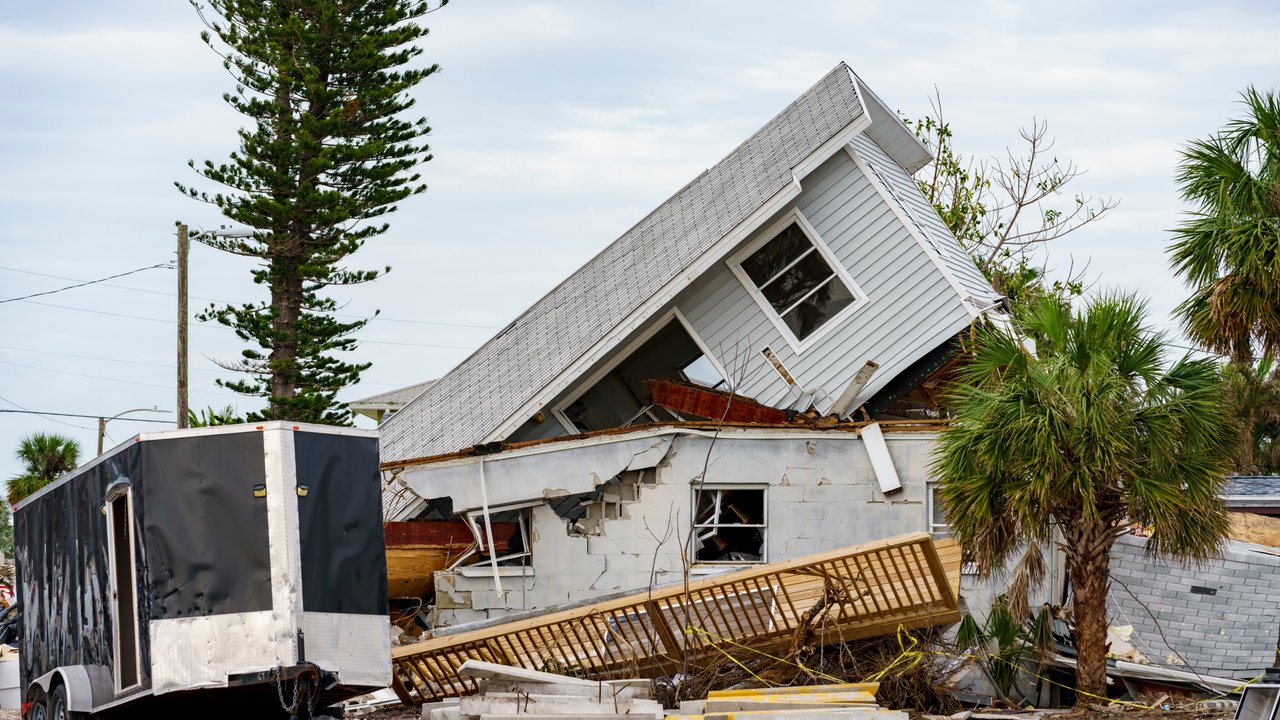Hurricanes, typhoons, cyclones
Tropical storms – The natural hazard with the highest losses
properties.trackTitle
properties.trackSubtitle
Tropical storms have enormous destructive potential. These storms, which are known as hurricanes, typhoons or cyclones depending on the ocean basin concerned, account for the highest losses of all natural disasters over time.
Take Hurricane Otis, for example, which devastated the holiday resort of Acapulco on the west coast of Mexico in October 2023. With wind speeds of up to 265 km/h, it was one of the strongest tropical storms to have ever made landfall. The costliest storm of all time was Hurricane Katrina, which hit New Orleans in 2005.
Tropical storms usually develop from the large-scale clusters of thunderstorm cells that are often seen over tropical oceans. They get their energy from the evaporation of surface water with a temperature higher than 26–27°C. When they reach a certain strength, they are called hurricanes in the Atlantic and Northeast Pacific, cyclones in the Indian Ocean and South Pacific, and typhoons in the Northwest Pacific.
Tropical storms can be active for several weeks and can stretch across a vast area, while wind speeds can reach more than 250 km/h, in some cases even exceeding 300 km/h. They mainly affect coastal regions and islands between latitudes 10° and 40° north and south of the Equator. After making landfall, tropical storms quickly weaken as they track inland. Despite this, they can still trigger extreme floods and landslides through the enormous water masses they have absorbed while over the warm sea.
Hurricanes are one of the biggest loss drivers in North America ...

In North America, hurricanes are one of the biggest loss drivers for the insurance industry. And wind speed is not the only factor involved. The storm surges and inland flooding that frequently accompany hurricanes also have a significant impact on the extent of the loss.
In 2024, a double disaster from two hurricanes in Florida caused the biggest losses of the year. Hurricane Helene destroyed assets worth US$ 56bn, and it was not only the powerful winds of 225 km/h that did the damage. Torrential rainfall led to extreme flooding in states to the north of Florida such as Georgia and North Carolina. Not long after this, Hurricane Milton caused enormous storm surge losses of US$ 38bn and the highest insured losses of the year at US$ 25bn.
In addition to the southeastern US states, the northeastern coast of North America (including Canada) is also vulnerable to hurricanes. Examples include Hurricane Sandy, which resulted in extreme losses across the New York metropolitan area in 2012, and Hurricane Fiona in 2022, which severely impacted the Canadian province of Nova Scotia.
... but many Asian countries have also been hit by severe storms in recent years

In many Asian countries, tropical cyclones also regularly cause billions of dollars in damage. The most destructive cyclone was Typhoon Doksuri in 2023, which brushed the Philippines and hit mainland China with wind speeds of 180 km/h. Doksuri caused extreme flooding due to heavy rain. Overall losses amounted to around US$ 25bn, of which US$ 2bn was insured.
Japan is regularly hit by tropical cyclones. Since the country as a whole is highly exposed to natural disasters, building standards are comparatively strict, and buildings and infrastructure are more stable than in many other countries. This helps to limit damage. Nevertheless, the two most expensive storms, Typhoons Jebi (2018) and Hagibis (2019), still caused overall losses of almost US$ 30bn when adjusted for inflation. In the case of Hagibis, extreme precipitation caused severe damage from flooding – in some places 1,000 mm of rain (1,000 litres per square metre) fell in two days.
Australia is particularly affected by very strong tropical cyclones along the entire northern coastal strip from Western Australia to Queensland. But even the big cities like Perth in the southwest or Brisbane in the east can be hit by tropical cyclones. Cyclones Dinah (1967), Tracy (1974) and Debbie (2017) were particularly destructive events. In March 2025, Cyclone Alfred made landfall near Brisbane and caused widespread flooding due to heavy precipitation.
Are hurricanes and typhoons becoming stronger because of climate change?
Natural climate cycles, such as the warm and cold phases affecting the surface temperatures of tropical oceans certainly influence tropical cyclone activity, but climate change also plays a role. This is what we currently know:
- Most scientific studies indicate that the number of tropical storms will remain virtually unchanged in most ocean regions until the end of the 21st century. However, it is expected that the proportion of major storms (Categories 4 and 5 on the Saffir-Simpson Scale) will increase in most regions. The risk is therefore definitely rising.
- Storms with extreme rainfall are also becoming more frequent. Experts also point to climate change as the factor behind the rapid intensification of tropical storms, which makes storm alerts more difficult.
- The natural climate pattern ENSO (El Niño/Southern Oscillation) in the Pacific Ocean also has a strong effect on storm activity, impacting extreme weather events practically around the globe. The two ENSO phases, El Niño and La Niña, which occur in a rhythm of several years, work in opposing ways: while El Niño phases tend to bring fewer hurricanes to the North Atlantic and more hurricanes to the Northeast Pacific, this pattern reverses during La Niña phases. Scientists are debating whether climate change is strengthening the ENSO fluctuations.
Newsletter
Solutions for assessing and managing risks
Preventive measures and better risk management, including stricter building codes and land use regulations, can limit losses caused by tropical storms and help to protect people. Insurance products are a key component in providing financial support to people, businesses and public services following disasters. In addition, risk-adjusted premiums offer price incentives in return for behaviour that will mitigate losses. In highly developed markets such as the United States, the majority of homeowners, small businesses and industries have insurance cover for storm damage.
But it is a different story with the flood risk: the insurance gap here is considerable, with only a relatively small proportion of material assets covered for flood damage. This is also the case for flood damage triggered by storm systems.
In developing and emerging countries, the insurance gap for direct storm damage is often close to 100%. Munich Re is involved in developing practical solutions in this context, in organisations such as the Insurance Development Forum, and as part of public-private partnerships. The aim is to improve loss prevention in low-income countries and enhance their ability to cope with catastrophe losses.
Reinsurance solutions
Industry solutions
Contact our experts











